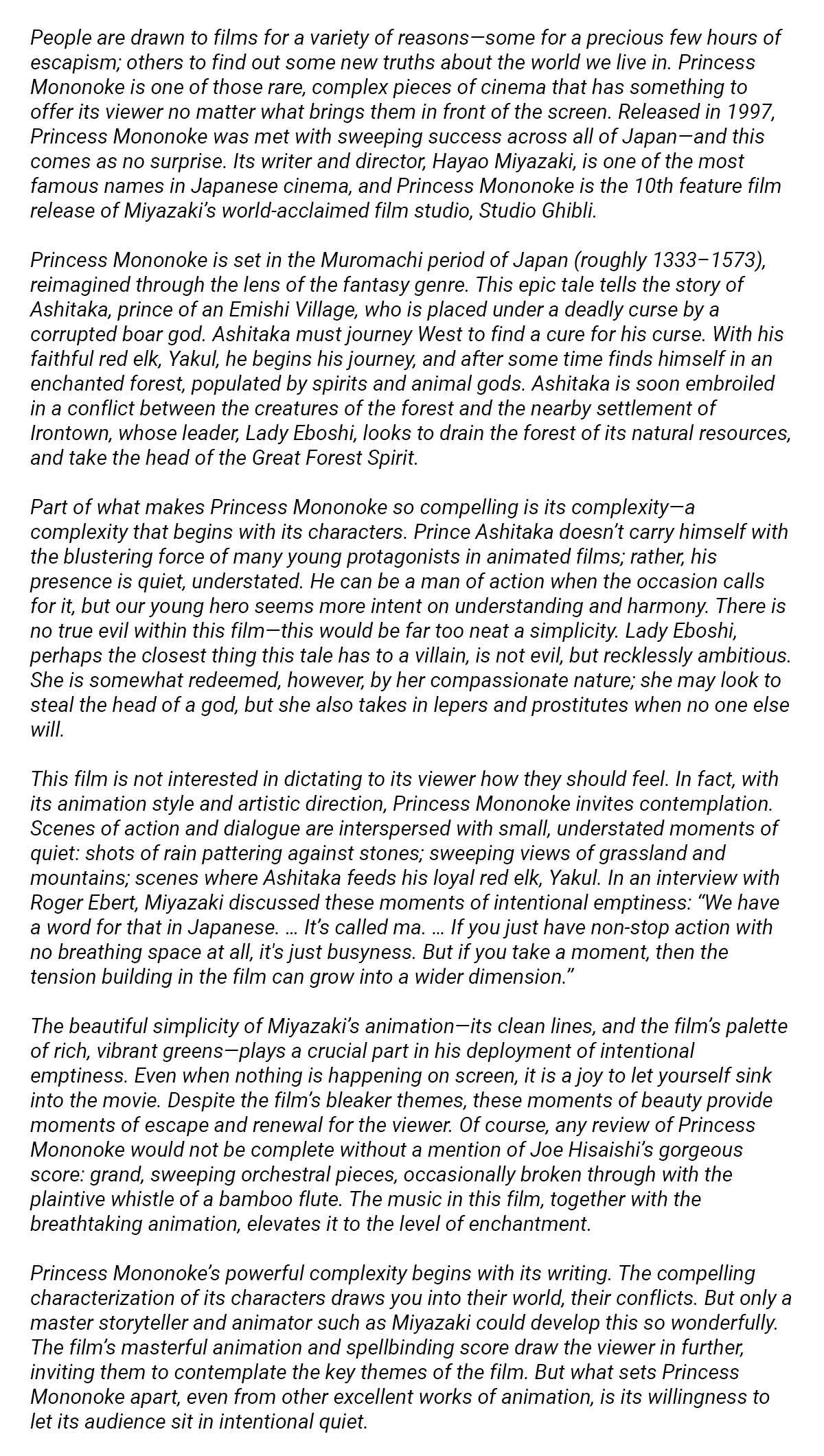Movie or book review writing, whether for a magazine or a school assignment, can present a unique challenge. It can be difficult to put one’s feelings about a visual form of media down in words, and more difficult still to figure out how to structure and format such a piece of work.
In this article, we’ll talk you through what exactly a film review essay is, what format and structure you should adopt while writing one, and how you can write a gripping introduction. We’ll also give you some examples of film reviews to help you generate some ideas for essays of your own.
Whether you’re wondering how to write a movie review for college or want to dazzle your high school teacher, this article will help you craft your perfect essay.
What Is a Movie Review Essay?
A movie review essay is a critical piece of writing that aims to give a well-rounded assessment and analysis of a film. Good assignments will consider the film from all angles, looking at everything from the writing and acting, to the direction and editing.
How are movies written in an essay? When answering “what is a movie review,” consider that these essays should be seen as far more than a summary of the film. Reviews can be works of art in and of themselves. They should entertain, educate, and persuade, and your written thesis should be original and compelling without necessarily spoiling the movie.
A good rule of thumb for such essays is that they should be a marriage of personal opinion and objective analysis. The most popular critics have their distinctive voice and style, and even different ideas of what makes a movie good, or even great; but they also have an understanding of film theory, and have a solid grasp of the fundamentals of cinematic technique.
So, now you understand what this kind of essay is; but how to write a movie review essay that is compelling? In the next section, we’ll consider the importance of format.
The Film Review Essay Format
Your movie review essay format depends on the audience you are writing for. Are you a high school student working on an assignment? A university student completing a piece of coursework? A writer for a cultural arts magazine? A movie review format for students might look quite different from the format of a magazine article.
Generally speaking, however, all movie reviews will have a similar format. Here are a couple of ideas as to what your paper might look like:
- Length. Movie reviews are not typically very long. On average, they range between 600-1200 words. If you’re writing this for university, you may be expected to produce a longer piece of work.
- Paragraphs. Film reviews should always be split up into paragraphs. Each paragraph should have a clear point and direction and should work to develop your central argument in an informative way.
Movie Reviews Structure
Regardless of the intended audience, a good film review will always stick to a rough structure. If you’re unsure of how to write a movie in a paper and especially how to structure a film review, check out these pointers:
- Introduction As with any essay, your review should begin with an introduction. This should include the title, date of release, and any relevant background information on the movie. If it’s based on a book, you might want to mention that, too. You should also make sure that you are clear from the get-go about your feelings on the film, opening your piece with a strong, compelling opinion. That way, your audience knows what to expect.
- Summary. Next, include a brief summary of the film. Your readers are here for your review, not a synopsis, so you don’t need to include every minute detail or plot twist. It’s enough just to outline the main elements of the story, making sure that you’re telling your readers enough that they won’t get lost.
- Description. The summary will give your audience a good idea of the content of the film, but your description should give a more detailed description of your personal experience of the movie. In this section, you should focus on the parts of the film that stand out in your mind; what did they look and sound like, and how did they make you feel?
- Analysis. Your essay analysis should form the bulk of the paper. In this section, you should deliver a critical interpretation of the movie, backing up your points with examples of scenes from the film. It might be helpful to refer back to your introduction while you’re writing, to make sure that you are supporting the opinion you laid out in the opening paragraph of your essay. You should analyze all aspects of the film, from direction and acting to setting and cinematography, highlighting the most interesting decisions. Also, consider the themes of the film and how the formal techniques highlight them.
- Conclusion. Your conclusion should recap your feelings on the film, reminding the reader of your overall impression. If you like, you could also say whether or not you recommend watching the film; whether you leave that explicit or implicit is up to you.
If you follow our advice on movie review structure, you’re sure to have a striking, thought-out essay. However, if you still find yourself unsure why not look up one of our movie review templates for college students?
Film Review Outline
Before you start writing the film review, it’s a good idea to put together a movie review outline. Having a strong outline means that you’ll be able to go into writing with a sense of direction. It is also useful to be able to refer back to a plan as you’re composing your essay. Doing so means that you won’t find yourself drifting off-topic, or going on meandering digressions.
Here are some tips for writing a good movie review essay outline:
- Brainstorm. Start by pooling together all of your ideas about the film and your review. You’ll think about what to include in a movie review. Don’t worry if some don’t seem relevant right now; just focus on getting it all down on the page.
- Decide on your thesis statement. If you haven’t already, try to decide on a central argument for your review. A good movie review paper doesn’t simply say “this film is bad,” or “this film is good.” Rather, a skillfully written review will try to prove a wider point about the movie. What is the point you would like to make? It’s alright if you don’t have a perfectly polished sentence ready to go, but you should at least have a solid idea. This will make planning your essay so much easier.
- Filter. Now that you’ve decided on a thesis statement, it’s time to go back through your brainstorming notes. With your thesis in mind, decide which points are most relevant to your paper and discard the ones that aren’t. If you’re not sure whether a note is relevant, ask yourself how it backs up your thesis statement; if you’re able to give a clear, insightful answer, then you know it should be included.
Before You Start Writing
If you’ve chosen a film to write on, you’ve already completed the first step of writing a film review. But there are several other things you should do before you even begin writing your essay:
- Watch and re-watch the film. Ideally, you should view the film multiple times before sitting down to write your review. Take notes while you watch, writing down any parts of the movie that stand out to you, or any questions you have while watching the film that you might want to research later.
- Research. At the very least, you will need to include a title, release date, and the names of the director, screenwriter, and perhaps even important actors in your review. However, you should also provide some additional context for your readers. It’s important, then, that you take the time to research the movie and its history. It may be worth checking out other reviews that have been written on the film as well. You don’t want to parrot the ideas of other critics, but reading what they have to say may help you generate a few ideas of your own.
- Outline. Before you sit down to write, it’s a good idea to put together a movie review essay outline. Include the key points you’re going to make in your essay and make note of what scenes from the film you’re going to use to back those points up.
Once you’ve followed these steps, you’re ready to start writing!
What to Include in a Movie Review Introduction
How to start a movie review essay? Well, as we’ve already talked about, your introduction should include some key elements. In any essay, your introduction should serve to draw in the readers. It should display your voice as a writer while showing that you have original, interesting ideas about the film you’re reviewing. Review essays should be not only informative but entertaining as well.
What to write in a movie review introduction?
- Title, release date, and important figures. Provide the title and release date, and the names of the director, screenwriter, and major actors.
- Context. You don’t need to trace the film’s entire history while movie review writing, but your audience will appreciate a little bit of context.
- Hook. In your introduction, you should include a fact or quote to grab your reader’s attention.
- Opinion.Make it clear exactly what your opinion is of the film. and introduce the central thesis of your essay.
If you include these central elements, you’re bound to write a memorable introduction—one that’s sure to grab the attention of your readers and stick with them long after they’ve finished reading your piece.
Want more info on how to write an introduction for a movie review? We’ve got you covered! Just check out these movie review introduction examples below.
🎓 Example Introduction: Midsommar (2019)
« Ari Aster’s latest film, Midsommar, is the director’s second feature film—and, as it happens, his second feature film about cults. Released in 2019 by independent entertainment company A24, this gore-fest was met with mixed reviews. Given the polarizing nature of its subject matter, perhaps this is not altogether surprising. Despite a cast of shallowly written characters, powered by at best flimsy psychology, the film may be worth a watch if only for its dazzling cinematography, and Bobby Krlic’s eerie soundscape. »
🎓 Example Introduction: The Lord of the Rings: The Fellowship of the Ring (2001)
« The first installment of Peter Jackson’s epic Lord of the Rings trilogy, The Fellowship of the Ring makes for a promising start. The film’s release in 2001 was a smashing success, and it’s not difficult to see why. A sweeping score and fantastical setting help bring J. R. R. Tolkien’s masterwork of fantasy fiction to life, while masterful performances from actors such as Ian McKellen and Viggo Mortensen help carry the emotional weight of this epic. »
Examples of Film Reviews
One of the best ways to see how to write a review essay on a movie is to read them for yourself. Below, you can find an example of a review of Hayao Miyazaki’s Princess Mononoke, a Japanese animated historical fantasy film released in 1997.
✍️ Example Review: Princess Mononoke (1997)

FAQ
What is the format of a movie review?
They are usually fairly short. Since you have limited space to make your argument, each paragraph in your review should carry your thesis statement forward.
What are the 7 steps to writing a movie review?
There are 7 key steps to writing a good movie review.
- Watch the film more than once.
- Do your research.
- Come up with a thesis statement.
- Outline your essay.
- Be aware of your audience.
- Discuss multiple techniques.
- Be analytical in your approach.
What should I write about in a movie essay?
In a movie essay, you should provide a thorough analysis of the film in question. Don’t just list things you did or didn’t like about the film. Rather, consider how they impact the film’s themes as a whole, and talk about why they were or were not effective.
What makes a good movie review?
A good movie essay is informative and educational, but also entertaining to read in its own right. It should be analytical and knowledgeable, while also retaining a personal edge. To see for yourself, look up movie review examples for college students.
How to start a movie review essay?
Start a movie essay by giving some basic information about the film, such as its title, date of release, and the names of any important figures involved in its release. Make sure that in your introduction you also introduce your thesis statement.






